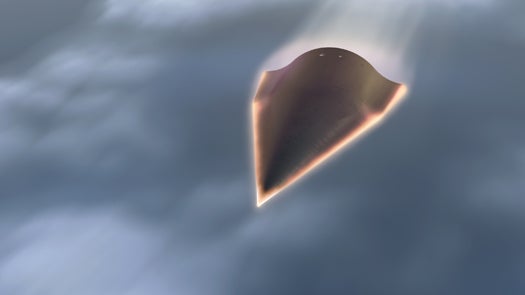DARPA’s HTV-2 Launches, Contact Lost, Status of Mission Remains Unclear [Updated]
Watch this space

Update: DARPA has gone silent regarding HTV-2, but its safe to assume at this point that contact with the hypersonic Falcon vehicle was lost before it fulfilled all of its mission objectives. No word yet on just how much data was collected or how many objectives were completed. More as this develops.
What looked to be a successful second launch of DARPA’s Falcon HTV-2 hypersonic vehicle has potentially taken a turn for the worse if DARPA’s Twitter feed is any indication. After successful launch, separation, contact with handlers on the ground, and entry into glide phase, the last we heard from DARPA via @DARPA_News doesn’t seem to bode well: “Range assets have lost telemetry with #HTV2. More to follow.”
That was almost an hour ago at the time of this posting, and more has not followed. So we don’t know if that translates to a fully successful flight or to some kind of vehicle failure. We’ll update here when we have more info.
HTV-2 was developed with one straightforward objective in mind: travel from anywhere on Earth to anywhere else on Earth in an hour. And with that goal in mind, DARPA has engineered a very fast vehicle. HTV-2 rides to near orbital speeds aboard a Minotaur rocket at which point it separates and enters a powered glide phase as it rides back to Earth at speeds topping Mach 20. That’s roughly 13,000 miles per hour (reportedly it is capable of a top speed approaching 17,000 miles per hour). In other words, fast enough to do New York to L.A. in 12 minutes, or London to Sydney in the aforementioned 60 minutes.
All that is easier said than done, though the benefits doing so aren’t difficult to articulate. One could deliver anything from cargo to warheads to (potentially) people with such a hypersonic vehicle, and HTV-2 is DARPA’s means of testing the technologies that could someday shrink the entire world to a one-hour journey.
Those technologies, however, are complex and as yet difficult to harness, and this wouldn’t be the first Falcon vehicle to end its mission early. During a test flight back in April of last year, DARPA’s first Falcon vehicle was lost nine minutes after launch. It was successfully delivered to its starting point, but engineers lost contact with the vehicle and a failsafe program put it into a controlled dive straight into the ocean.
But DARPA describes the vehicle as a “data truck” due to its heavy sensor payload, and even an abbreviated flight drastically informs the field of hypersonic flight. The agency’s engineers used the data collected from that failed first attempt to tweak the design of their new HTV-2 and its mission, lowering the angle of attack and adjusting its center of gravity.
Those adjustments seemed to be working early in today’s flight, and maybe they worked all the way through. When DARPA tells us something, we’ll tell you. In the meantime, brush up on HTV-2 via a mashup of DARPA vids below.
